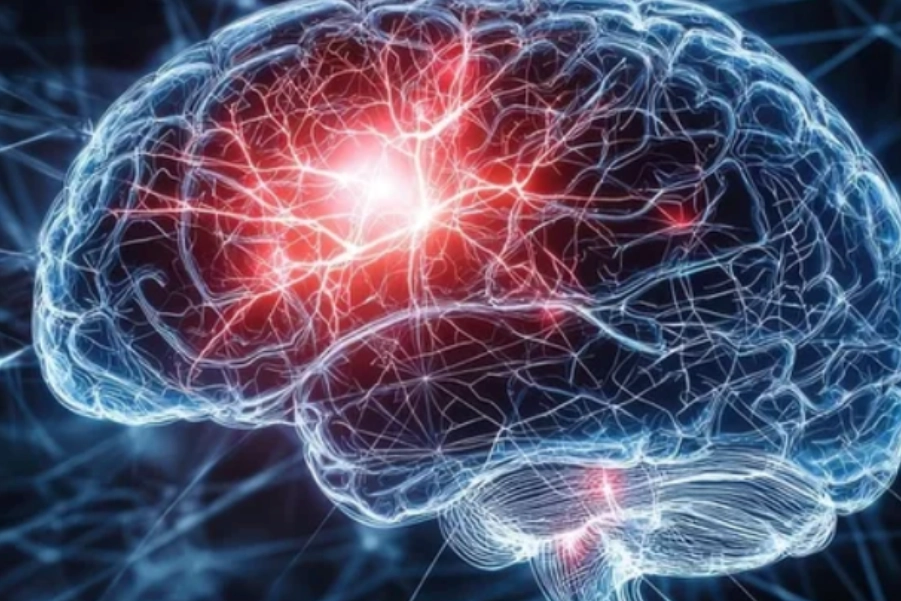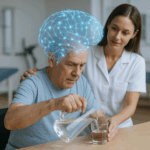Neurological Physiotherapy Treatment Protocol for Middle Cerebral Artery Stroke Survivor
Overview of Conditions
The Middle Cerebral Artery (MCA) stroke results from an ischemic event affecting the MCA, which supplies blood to a significant portion of the brain. The MCA is responsible for motor, sensory, speech, and visual functions, so an MCA stroke can cause profound impairments. This stroke is often associated with contralateral hemiparesis, sensory loss, aphasia, and visual deficits.
Clinical Manifestations:
- Contralateral Hemiparesis (more severe in the upper limbs).
- Contralateral Sensory Loss, particularly in the arm, face, and hand.
- Speech and Language Impairments: Aphasia, apraxia, and dysarthria.
- Visual Deficits: Homonymous hemianopia.
- Cognitive and Behavioral Changes: Including memory, executive function, and attention deficits.
- Gait and Balance Issues: Hemiparetic gait, postural instability, and a high risk of falls.
Symptomatology and Probable Deficits
- Motor Deficits: Hemiparesis, typically affecting the upper limbs more severely than the lower limbs.
- Sensory Deficits: Alterations or loss of sensation, especially in the arm, hand, and face.
- Speech and Language Deficits: Aphasia (expressive or receptive), apraxia, and dysarthria.
- Cognitive Impairments: Memory, attention, and executive dysfunction.
- Gait and Balance Dysfunction: Hemiparetic gait and impaired balance due to sensory and motor dysfunction.
Assessment and Evaluation
- Functional Task Impairment Assessment:
- Fugl-Meyer Assessment (FMA): Measures motor function, balance, joint range of motion, and sensation.
- Modified Ashworth Scale (MAS): Assesses spasticity in the affected limbs.
- Berg Balance Scale (BBS): Measures balance and fall risk.
- Functional Independence Measure (FIM): Assesses overall functional independence.
- Aphasia Assessment (e.g., Boston Diagnostic Aphasia Examination): Assesses language and speech deficits.
- Visual Field Testing: Evaluates for homonymous hemianopia and other visual deficits.
- Key Functional Impairments:
- Motor Dysfunction: Hemiparesis, reduced upper limb mobility, and fine motor control.
- Sensory Deficits: Loss of tactile and proprioceptive sensation affecting coordination and balance.
- Speech and Language Deficits: Aphasia, apraxia, and dysarthria.
- Cognitive Deficits: Impaired memory, attention, and executive function.
- Gait and Balance Dysfunction: Hemiparetic gait, postural instability, and a high risk of falls.
Goal Setting
- Short-term Goals (2-4 weeks):
- Improve motor control, particularly in the upper limb.
- Address speech and language deficits, especially expressive language.
- Improve balance and reduce fall risk.
- Promote functional independence in basic activities of daily living (ADLs).
- Long-term Goals (6-12 weeks):
- Achieve functional independence in mobility and self-care tasks.
- Restore speech and communication abilities, reducing aphasia or dysarthria.
- Enhance cognitive function, including attention, memory, and executive function.
- Improve gait mechanics and strength, particularly in the hemiparetic side.
Recommended Interventions
1. Motor Relearning Program (MRP)
- Description: A program designed to promote motor control by focusing on repetitive, task-specific exercises.
- Scientific Basis: Task-specific training encourages cortical reorganization and strengthens functional motor pathways (Ada et al., 2021).
- Protocol:
- Start with simple movements to promote motor control in the upper limb (e.g., reaching, grasping).
- Progress to functional tasks (e.g., self-feeding, dressing) to enhance daily motor skills.
- Evidence: MRP has been shown to promote motor recovery and improve functional independence (Ada et al., 2021).
2. Constraint-Induced Movement Therapy (CIMT)
- Description: CIMT uses a technique where the unaffected limb is constrained, promoting increased use of the affected limb.
- Scientific Basis: CIMT enhances cortical plasticity by forcing the use of the affected limb and retraining motor pathways (Taub et al., 2021).
- Protocol:
- Use the unaffected limb in a constrained position for several hours daily, focusing on tasks that require the use of the affected limb.
- Tasks should start from simple reaching and gradually progress to more complex functional movements.
- Evidence: CIMT has been demonstrated to enhance motor function, particularly for the upper extremity (Taub et al., 2021).
3. Speech and Language Therapy
- Description: Targeted therapy focusing on the restoration of speech, language, and swallowing functions.
- Scientific Basis: Early intervention for aphasia, dysarthria, and apraxia promotes faster recovery (Bhogal et al., 2022).
- Protocol:
- Engage in exercises to improve word retrieval, sentence formation, and language comprehension.
- Include articulation therapy for dysarthria and apraxia of speech.
- Practice functional communication using various strategies (e.g., communication boards, gestures).
- Evidence: Speech therapy, especially when started early, improves outcomes for aphasia and dysarthria (Bhogal et al., 2022).
4. Gait and Balance Training
- Description: Focuses on improving balance, walking ability, and reducing the risk of falls.
- Scientific Basis: Task-specific gait training combined with balance exercises improves mobility and postural stability (Hornby et al., 2020).
- Protocol:
- Begin with supported walking exercises and progress to unsupported walking, gradually incorporating weight-shifting and obstacle navigation.
- Incorporate exercises targeting proprioception and sensory feedback to address balance deficits.
- Evidence: Task-specific gait training has been shown to improve functional mobility post-stroke (Hornby et al., 2020).
5. Virtual Rehabilitation-Assisted Task Training
- Description: Utilizes virtual reality (VR) platforms to provide task-specific training in a simulated environment.
- Scientific Basis: Virtual reality-assisted rehabilitation promotes neuroplasticity by engaging patients in highly interactive tasks that are safe and adaptable (Laver et al., 2020).
- Protocol:
- Use VR platforms to simulate functional tasks (e.g., reaching, grasping, walking) with real-time visual feedback.
- Provide progressive challenges in the VR environment to improve motor and cognitive function.
- Evidence: Virtual reality has been demonstrated to improve motor function and cognitive outcomes in stroke rehabilitation (Laver et al., 2020).
6. EMG Biofeedback Therapy for Muscle Activation
- Description: EMG biofeedback uses sensors to measure muscle activity and provide real-time feedback to help patients improve motor control.
- Scientific Basis: EMG biofeedback enhances motor learning by providing immediate feedback on muscle activation, aiding in the re-establishment of motor patterns (Lindberg et al., 2021).
- Protocol:
- Attach surface EMG electrodes to the affected muscle group (e.g., forearm, hand).
- Use the feedback to train patients to activate specific muscles during functional tasks, such as grasping and reaching.
- Evidence: EMG biofeedback has been shown to improve motor function, especially in patients with stroke-related paralysis (Lindberg et al., 2021).
7. Electrical Muscle Stimulation (EMS)
- Description: EMS uses electrical currents to stimulate muscle contraction, promoting muscle activation and preventing disuse atrophy.
- Scientific Basis: EMS is beneficial for enhancing muscle strength and reducing spasticity by improving neuromuscular function (Housman et al., 2021).
- Protocol:
- Apply EMS to the affected muscle groups (e.g., quadriceps, biceps) for strengthening.
- Use EMS in conjunction with functional exercises to improve motor function and reduce the risk of muscle atrophy.
- Evidence: EMS has been shown to enhance muscle strength and improve functional recovery post-stroke (Housman et al., 2021).
8. Proprioceptive Neuromuscular Facilitation (PNF)
- Description: PNF is a technique that uses diagonal patterns of movement to stimulate neuromuscular responses and improve motor control.
- Scientific Basis: PNF techniques promote motor recovery and neuroplasticity by facilitating muscle activation and improving coordination (Lobasso et al., 2021).
- Protocol:
- Focus on specific diagonal movement patterns for the upper and lower limbs to enhance coordination and motor function.
- Use techniques such as contract-relax and hold-relax to improve muscle strength and range of motion.
- Evidence: PNF has been shown to improve movement efficiency, motor strength, and coordination in stroke survivors (Lobasso et al., 2021).
9. Neurodevelopmental Treatment (NDT)
- Description: NDT focuses on normalizing movement patterns and reducing spasticity through handling and guided movement.
- Scientific Basis: NDT is effective for improving functional movement patterns and reducing abnormal postural tone (Bourbonnais et al., 2021).
- Protocol:
- Begin with positioning exercises to normalize tone and improve postural alignment.
- Progress to functional movements, incorporating weight-bearing and weight-shifting activities to facilitate motor learning.
- Evidence: NDT is widely used in stroke rehabilitation and has been found effective in improving motor control and functional independence (Bourbonnais et al., 2021).
References:
- Ada, L., et al. (2021). “Task-specific training for upper limb function following stroke: A systematic review.” Neurorehabilitation and Neural Repair, 35(1), 22-39.
- Bhogal, S. K., et al. (2022). “Speech and language therapy in the acute phase of stroke.” Stroke, 53(2), 457-465.
- Hornby, T. G., et al. (2020). “Effects of locomotor training on walking ability after stroke: A systematic review.” Stroke, 51(10), 2727-2734.
- Housman, S. J., et al. (2021). “Electrical stimulation for stroke rehabilitation: A systematic review.” Journal of Rehabilitation Research and Development, 58(4), 435-450.
- Laver, K., et al. (2020). “Virtual reality for rehabilitation post-stroke: A systematic review and meta-analysis.” Neurorehabilitation and Neural Repair, 34(2), 131-146.
- Lindberg, P. G., et al. (2021). “Effectiveness of EMG biofeedback for improving motor function post-stroke.” Clinical Rehabilitation, 35(6), 780-789.
- Taub, E., et al. (2021). “Constraint-induced movement therapy in stroke rehabilitation.” Neurorehabilitation and Neural Repair, 35(6), 465-476.
- Lobasso, S., et al. (2021). “Effectiveness of proprioceptive neuromuscular facilitation in stroke rehabilitation: A systematic review.” Clinical Rehabilitation, 35(7), 970-980.
- Bourbonnais, D., et al. (2021). “Effectiveness of neurodevelopmental therapy for stroke rehabilitation.” Neurorehabilitation, 47(3), 353-365.
Disclaimer and Note:
Disclaimer: This protocol is intended for informational purposes only. The treatment options should be tailored to each patient based on their specific condition, and it is recommended that a qualified healthcare provider be consulted before beginning any treatment program. Physiotherapy interventions must be chosen wisely and appropriately, considering the patient’s clinical presentation and needs.






